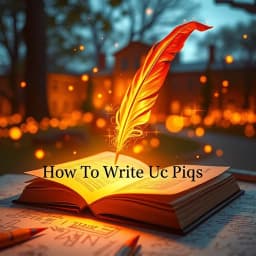
How to Write UC PIQs
Find this useful? Bookmark ( CTRL/CMD + D ) for quick access!
Try an example:
Personal Statement Guidance
College Application Essays
UC PIQ Brainstorming
Reflective Writing Prompts
Storytelling Techniques
Editing and Feedback Tools
Explore Similar Tools
Recent Generations
the amount paid directly to you. Yes it is possible in future cases to request direct payment to the provider, Rephrase and give me polished email.
we have processed the claim as per the attachments in the claim submission we have processedthe invoice for Saul Holding. We dont have invoice for the Salofalk.
this additional information is very important. this adiitional information was requested by our clinical team. Without clinical review claim not be paid so please share the below additional information
How To Write Uc Piqs
How To Write Uc Piqs is a powerful AI-driven writing assistant designed to help users craft compelling personal insight questions (PIQs) for University of California applications. This innovative tool combines advanced natural language processing with tailored guidance to deliver high-quality, authentic responses that resonate with admissions committees.
Key Capabilities
- Personalized Writing Prompts: Generate customized prompts based on your unique experiences and aspirations, ensuring your PIQs reflect your individuality.
- Real-Time Feedback: Receive instant suggestions and edits to enhance clarity, coherence, and emotional impact, making your writing more engaging and effective.
- Sample Responses and Templates: Access a library of successful PIQ examples and templates to inspire your writing and help structure your responses.
- Plagiarism Detection: Ensure originality with built-in plagiarism checks, giving you confidence that your submissions are unique and authentic.
Who It's For
Designed for prospective University of California students, How To Write Uc Piqs excels in helping applicants articulate their personal stories and experiences. Whether you're a high school senior preparing your college applications or a transfer student looking to showcase your journey, this tool streamlines the writing process and enhances your chances of admission.
Why Choose How To Write Uc Piqs
What sets How To Write Uc Piqs apart is its focus on authenticity and personalization, making it the ideal solution for students aiming to stand out in a competitive admissions landscape.
Ready to transform your college application experience? Start using How To Write Uc Piqs today and craft compelling PIQs that make a lasting impression!
Enhance Your Work with How to Write UC PIQs
Leverage the power of AI to streamline your tasks with our How to Write UC PIQs tool.
Personalized Guidance
Receive tailored advice and tips for crafting compelling UC PIQs that reflect your unique experiences and voice.
Resource Library
Access a comprehensive library of examples, templates, and writing resources to enhance your writing process.
Feedback and Revision
Utilize AI-driven feedback tools to refine your essays, ensuring clarity, coherence, and impact before submission.
How How to Write UC PIQs Works
Discover the simple process of using How to Write UC PIQs to improve your workflow:
Understand the Requirements
Familiarize yourself with the UC PIQs (Personal Insight Questions) to understand what is expected.
Brainstorm Ideas
Generate ideas and personal experiences that align with the prompts provided by UC.
Draft Your Responses
Write initial drafts of your responses, focusing on clarity and authenticity.
Revise and Finalize
Review your drafts for coherence, grammar, and adherence to the word limit before submission.
Use Cases of
How to Write UC PIQs
Explore the various applications of How to Write UC PIQs in different scenarios:
Personal Statement Development
Assist students in crafting compelling personal statements for college applications by providing structured guidance and examples.
UC PIQ Strategy Planning
Help applicants develop a strategic approach to answering University of California Personal Insight Questions (PIQs) by identifying key themes and experiences.
Feedback and Revision
Offer constructive feedback on draft responses to UC PIQs, helping users refine their writing and enhance clarity and impact.
Time Management for Applications
Guide users in creating a timeline for completing UC applications, ensuring they allocate sufficient time for brainstorming, writing, and revising their PIQs.
Who Benefits from How to Write UC PIQs?
AI-Powered Efficiency
From individuals to large organizations, see who can leverage How to Write UC PIQs for improved productivity:
High School Students
Learn how to effectively articulate personal experiences and aspirations in UC PIQs.
College Applicants
Enhance your application by crafting compelling and unique personal insight questions.
Educators and Counselors
Guide students in developing their writing skills for UC PIQs and improve their chances of admission.
Admissions Officers
Utilize a standardized approach to evaluate applicants' personal insights effectively.
Frequently Asked Questions
What are UC PIQs and why are they important?
UC PIQs, or University of California Personal Insight Questions, are a set of prompts that allow applicants to showcase their unique experiences, perspectives, and achievements. They are crucial for admissions as they help the university understand the applicant beyond grades and test scores.
How does the 'How To Write UC PIQs' tool assist users?
The tool provides guidance on how to effectively respond to each of the UC PIQs. It offers tips on structure, content, and style, helping users to articulate their thoughts clearly and compellingly.
Is the tool suitable for all applicants?
Yes, the tool is designed for all types of applicants, including high school students, transfer students, and international applicants. It provides tailored advice to meet the diverse needs of different users.
Can I get feedback on my responses using this tool?
While the tool offers writing tips and examples, it does not provide personalized feedback on individual responses. However, users are encouraged to seek feedback from teachers, mentors, or peers for additional insights.
Is there a cost associated with using the 'How To Write UC PIQs' tool?
The basic version of the tool is free to use, providing essential guidance and resources. There may be premium features available for a fee, which offer more in-depth assistance and personalized support.
































